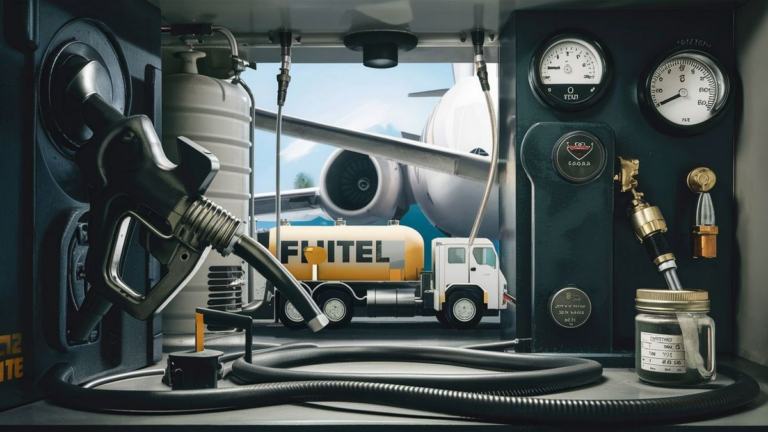Aircraft fuel, also known as aviation fuel or avtur, is a specialized type of fuel utilized to power aircraft. It is a vital component that ensures the safe and efficient operation of various types of aircraft, ranging from small private planes to large commercial airliners and military jets.
Unlike the fuel used in automobiles, aircraft fuel is formulated to meet stringent performance requirements specific to aviation. It is designed to provide high energy density, optimal combustion characteristics, and reliable performance across a wide range of operating conditions, including extreme temperatures and altitudes.
The Composition of Aircraft Fuel
Aircraft fuel typically consists of hydrocarbon compounds derived from crude oil through a refining process. The most common type of aviation fuel used worldwide is Jet A-1, which is a kerosene-based fuel. Jet A-1 is widely available and meets the specifications set by international aviation authorities.
Jet A-1 fuel is a refined product with controlled properties to ensure consistent performance and safety. It contains additives to prevent icing, inhibit corrosion, and enhance lubrication, all of which are essential for the reliable operation of aircraft engines.
Types of Aircraft Fuel
While Jet A-1 is the standard aviation fuel used in commercial aviation, there are other types of aircraft fuel tailored for specific applications:
- Jet A: Similar to Jet A-1 but with a slightly higher freezing point. It is primarily used in regions with warmer climates.
- AvGas: Also known as aviation gasoline, AvGas is used in piston-engine aircraft. It has a different composition compared to jet fuel and is not interchangeable with Jet A-1 or Jet A.
Importance of Aircraft Fuel Quality
The quality of aircraft fuel is of paramount importance for aviation safety and efficiency. Contaminants or impurities in the fuel can lead to engine malfunctions, reduced performance, and potentially catastrophic incidents. Therefore, rigorous quality control measures are in place throughout the production, transportation, and storage of aviation fuel.
Aviation authorities and regulatory bodies establish strict standards and specifications for aircraft fuel, ensuring that it meets the required purity, chemical composition, and performance criteria. Compliance with these standards is mandatory for all stakeholders involved in the aviation fuel supply chain.
Storage and Handling of Aircraft Fuel
Aircraft fuel is typically stored in dedicated facilities, such as airport fuel farms, where it is stored in large tanks and distributed to aircraft via underground pipelines or tanker trucks. Specialized equipment and procedures are employed to minimize the risk of contamination and ensure the integrity of the fuel.
Proper handling and storage practices are essential to maintain the quality of aircraft fuel and prevent safety hazards. Stringent protocols govern the inspection, testing, and maintenance of fuel storage facilities to mitigate risks and ensure compliance with regulatory requirements.
Environmental Considerations
Like any hydrocarbon-based fuel, aircraft fuel combustion releases carbon dioxide (CO2) and other greenhouse gases into the atmosphere, contributing to climate change and environmental pollution. As a result, the aviation industry is actively exploring alternative fuels and sustainable aviation initiatives to reduce its carbon footprint and mitigate environmental impact.
Biofuels derived from renewable sources, such as biomass or algae, hold promise as greener alternatives to conventional aviation fuel. Research and development efforts are underway to improve the efficiency and scalability of biofuel production and distribution, paving the way for a more sustainable future for air travel.
Aircraft fuel is a critical component of modern aviation, powering aircraft of all sizes and types around the world. Its composition, quality, and handling are subject to rigorous standards and regulations to ensure the safety, reliability, and efficiency of air travel. As the aviation industry continues to evolve, advancements in fuel technology and sustainability will play a crucial role in shaping the future of flight.
Frequently Asked Questions
Here are some commonly asked questions about aircraft fuel:
| Question | Answer |
|---|---|
| 1. Is aviation fuel the same as car fuel? | No, aviation fuel is specially formulated for use in aircraft and differs from automotive fuel in composition and performance characteristics. |
| 2. What are the main types of aircraft fuel? | The main types include Jet A-1, Jet A, and AvGas. Jet A-1 is the standard for commercial aviation, while Jet A is used in warmer climates, and AvGas is for piston-engine aircraft. |
| 3. How is aircraft fuel stored and handled? | Aircraft fuel is stored in dedicated facilities like airport fuel farms and distributed via pipelines or tanker trucks. Specialized protocols ensure proper handling to maintain quality and safety. |
| 4. What environmental considerations are associated with aircraft fuel? | Aircraft fuel combustion emits greenhouse gases contributing to climate change. Efforts are underway to explore alternative fuels and sustainable aviation initiatives to mitigate environmental impact. |
Safety Regulations and Compliance
Ensuring compliance with safety regulations is paramount in the aviation industry, particularly concerning aircraft fuel. Regulatory bodies set stringent standards for fuel quality, storage, and handling to safeguard against potential hazards and ensure operational integrity.
These regulations encompass various aspects, including storage tank specifications, inspection protocols, personnel training requirements, and emergency response procedures. Adherence to these regulations not only enhances safety but also fosters public trust and confidence in air travel.
Storage Tank Specifications
Storage tanks for aircraft fuel must meet specific design and construction standards to prevent leaks, corrosion, and other structural failures. These standards outline requirements for materials, coatings, reinforcement, and seismic considerations to mitigate risks and ensure long-term reliability.
Additionally, tanks are equipped with monitoring systems to detect any anomalies or deviations from normal operating conditions promptly. Regular inspections and maintenance procedures are conducted to identify and address potential issues before they escalate into safety concerns.
Personnel Training and Emergency Response
Personnel involved in the handling, storage, and transportation of aircraft fuel undergo rigorous training programs to ensure competency in safety procedures and emergency response protocols. This training covers aspects such as spill containment, firefighting techniques, first aid, and evacuation procedures.
In the event of an emergency, swift and effective response is critical to mitigate risks and minimize potential harm to personnel, property, and the environment. Emergency response plans are developed and regularly reviewed to ensure readiness and coordination among stakeholders, including airport authorities, fuel suppliers, and regulatory agencies.
Future Trends in Aircraft Fuel
The aviation industry is witnessing ongoing advancements in aircraft fuel technology and sustainability initiatives aimed at reducing environmental impact and enhancing operational efficiency.
One notable trend is the development and adoption of sustainable aviation fuels (SAF), which are derived from renewable feedstocks such as plant biomass, waste oils, or synthetic processes powered by renewable energy sources. SAF offer potential greenhouse gas emissions reductions compared to conventional fossil fuels, making them an attractive option for mitigating aviation’s environmental footprint.
Furthermore, research and development efforts are underway to explore novel fuel formulations, combustion technologies, and propulsion systems that optimize fuel efficiency, reduce emissions, and enhance aircraft performance. These innovations hold promise for shaping the future of aviation fuel and advancing sustainability goals in the aerospace sector.






